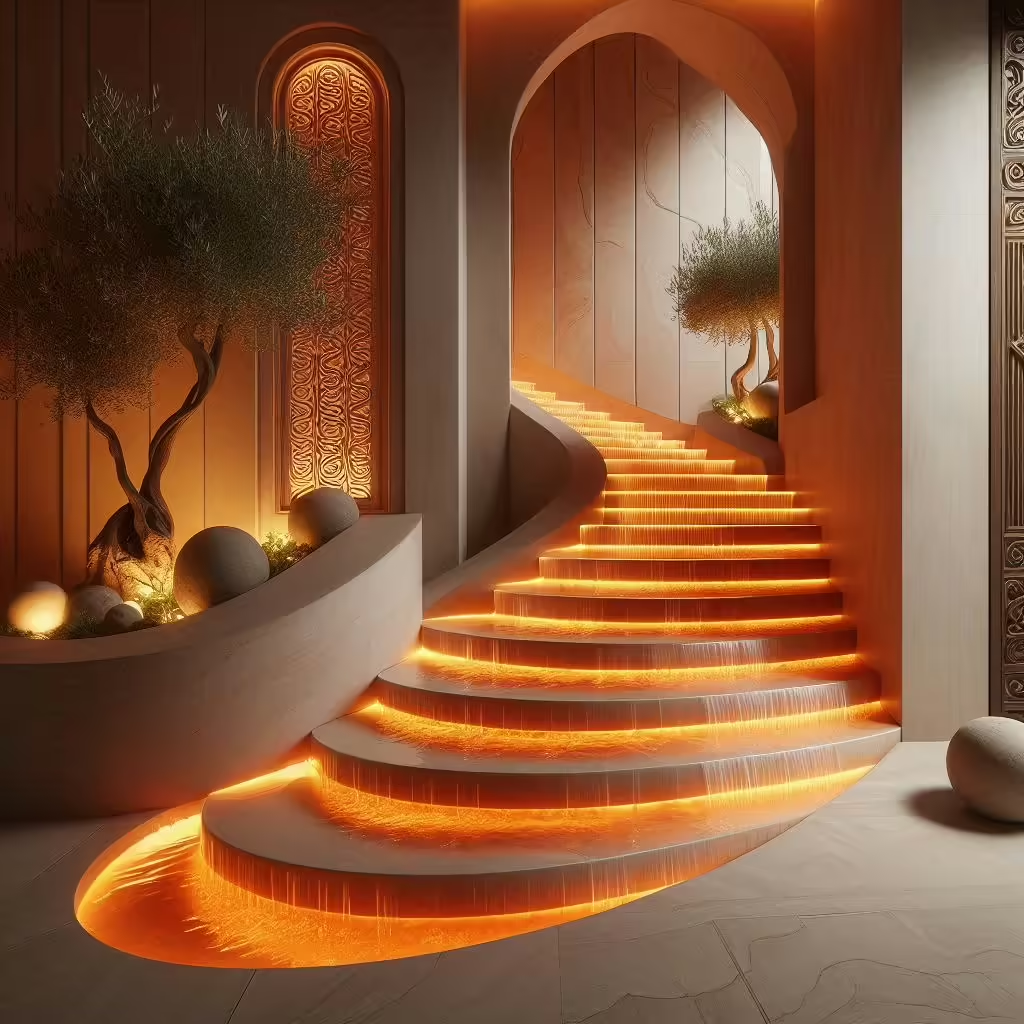Staircases often serve as the backbone of a home’s architectural structure, offering both functionality and aesthetic appeal. However, the days of conventional staircases are dwindling as more homeowners seek to make bold statements through unique designs. One design trend that has captured the imagination of modern homeowners and designers alike is the waterfall-inspired staircase. Combining the soothing elements of nature with innovative architecture, these staircases mimic the gentle flow of cascading water, creating an enchanting focal point in any home.
In this blog post, we will delve into the key aspects of waterfall-inspired staircases, explore how to integrate them into various home styles, and discuss the materials and design features that make these staircases an architectural masterpiece. Whether you’re designing a new home or remodeling an existing one, a waterfall-inspired staircase can transform your space into a serene retreat.
What is a Waterfall-Inspired Staircase?
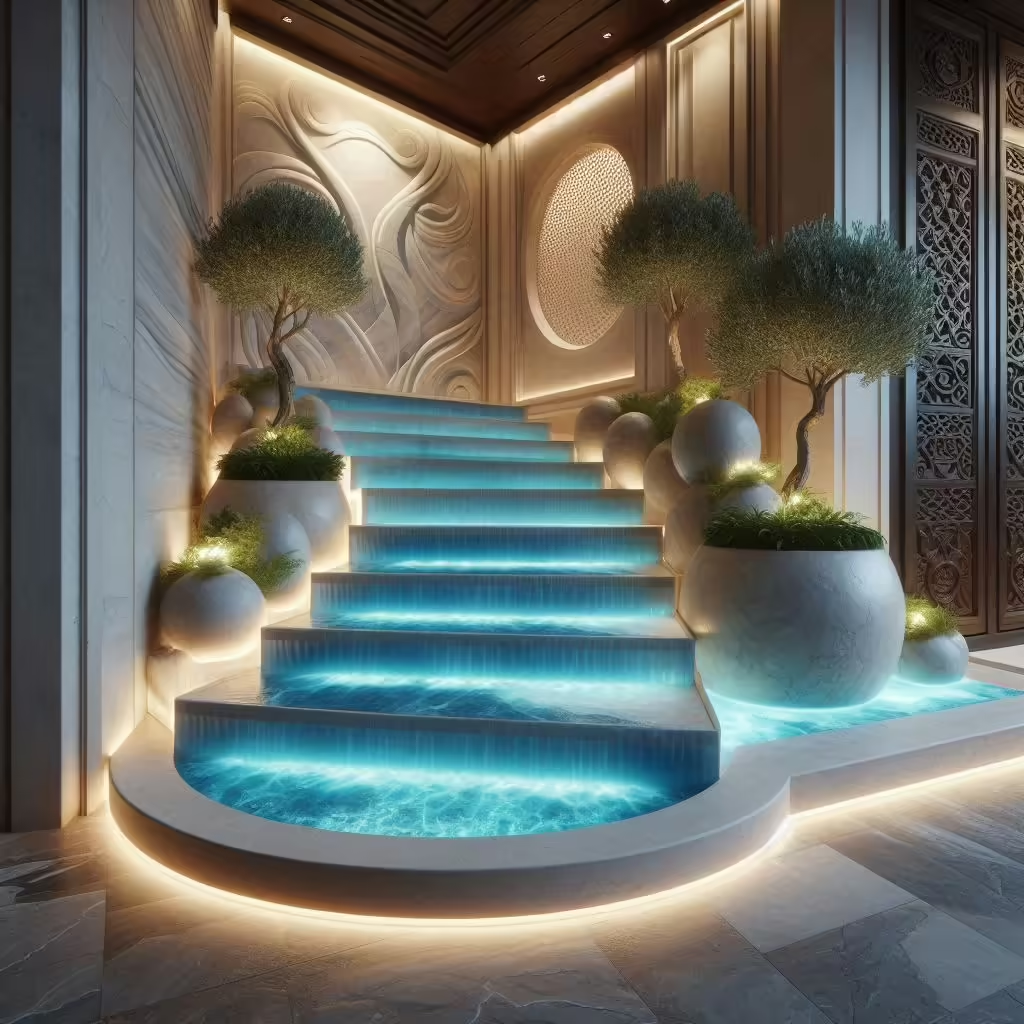
A waterfall-inspired staircase takes its name from the visual and conceptual appeal of flowing water. The design mimics the fluid motion and smooth contours of a waterfall, often with gentle, sweeping curves and seamless transitions. Unlike traditional staircases that are more rigid and angular, waterfall-inspired designs offer a soft, organic feel, bringing a touch of nature indoors.
The Essence of Natural Flow
The primary concept behind a waterfall-inspired staircase is the emulation of nature. Much like a waterfall that cascades gently over rocks, these staircases are designed to flow effortlessly from one level to the next. This gives the staircase an ethereal quality, making it more than just a functional structure—it becomes an art piece within the home.
Benefits of a Waterfall-Inspired Staircase
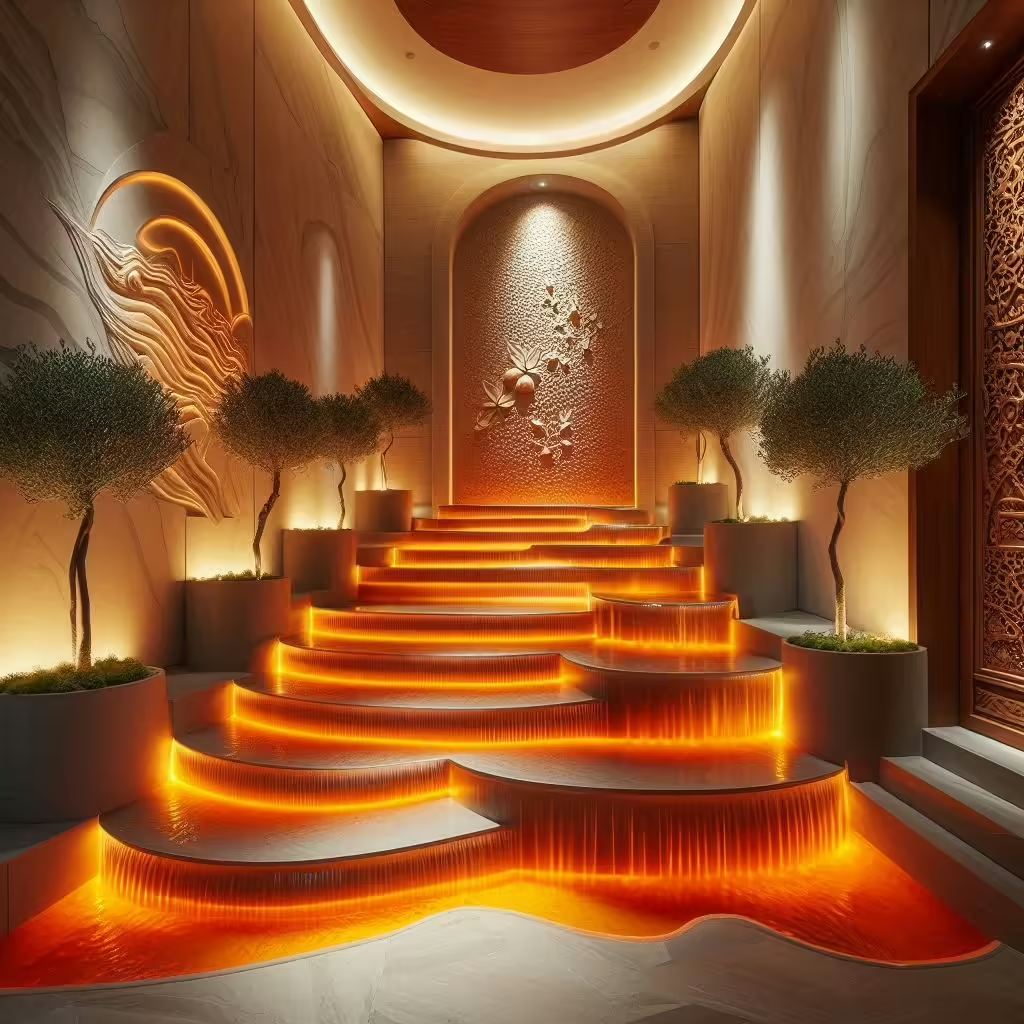
Aesthetic Appeal
The first and most obvious benefit of a waterfall-inspired staircase is its stunning visual appeal. Whether you prefer a minimalist design or a more luxurious one, the organic flow of these staircases adds a sense of tranquility and movement to the space. The design feels less mechanical and more like a piece of art.
Enhanced Home Value
An eye-catching staircase can significantly increase the value of your home. A waterfall-inspired design is not only unique but also memorable, making it an attractive feature for potential buyers. It offers a level of sophistication that sets your home apart from others on the market.
Connection to Nature
Integrating a waterfall-inspired staircase into your home provides a connection to nature. Waterfalls evoke a sense of peace, calm, and serenity, which can translate into your living space. This nature-inspired design can create a sanctuary-like environment, offering a daily retreat from the hustle and bustle of everyday life.
Customization Opportunities
No two waterfall-inspired staircases are alike. They offer endless opportunities for customization, from the materials used to the design of the railing and the lighting that enhances the overall effect. Whether you prefer wood, glass, stone, or metal, you can create a staircase that reflects your personal taste and the architectural style of your home.
Design Elements to Consider for a Waterfall-Inspired Staircase
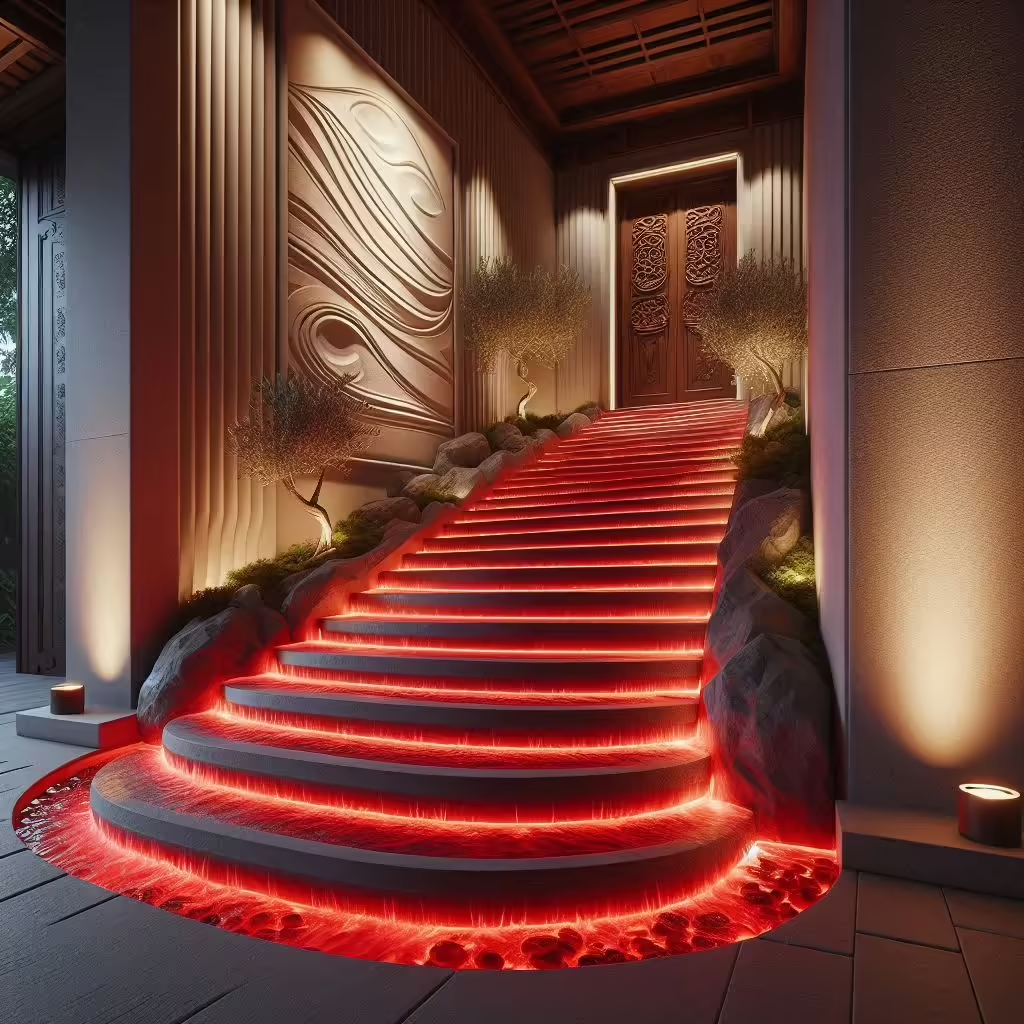
Curved Steps
The hallmark of a waterfall-inspired staircase is its curved steps. These soft, rounded edges imitate the flow of water, creating a visual and tactile experience. Curved staircases also have a practical benefit: they make for a smoother ascent and descent, as there are no harsh angles to navigate.
Seamless Transitions
A key aspect of this design is seamlessness. The steps should appear as though they are part of a continuous flow, much like water cascading over rocks. To achieve this, avoid sharp angles and abrupt changes in materials or colors. Instead, opt for smooth, gradual transitions between the steps and the landings.
Glass Railings
To maintain the illusion of a flowing waterfall, glass railings are an excellent choice. They offer an unobstructed view of the staircase, allowing the fluidity of the design to take center stage. Additionally, glass railings add a modern touch while enhancing the sense of openness in your home.
Lighting
Strategic lighting can make all the difference in accentuating the beauty of a waterfall-inspired staircase. Soft, ambient lighting beneath each step can create the effect of water gently cascading down the staircase. This not only enhances the visual appeal but also ensures safety by illuminating the steps.
Materials for a Waterfall-Inspired Staircase
The materials you choose for your waterfall-inspired staircase will play a significant role in its overall aesthetic and durability. Here are some of the top material options:
Wood
Wood is a classic choice for any staircase, and it works beautifully for a waterfall-inspired design. Opt for rich, natural tones to mimic the earthy feel of a waterfall in the wild. Dark woods like walnut or lighter options like maple can both be used depending on your desired ambiance.
Glass
For a modern, sleek look, glass steps or glass railings can give the illusion of transparency and lightness. This material allows the staircase to blend seamlessly with its surroundings, enhancing the waterfall effect.
Stone
Stone steps can add a natural, rugged feel to the design, especially if you’re going for a more rustic or earthy theme. Materials like marble, granite, or even limestone can create a beautiful contrast with the fluid design of the staircase while reinforcing the connection to nature.
Metal
If you’re looking for a more industrial or contemporary aesthetic, consider metal. Sleek stainless steel or brushed aluminum can add a sophisticated edge to the soft, flowing lines of a waterfall-inspired staircase.
Where to Place a Waterfall-Inspired Staircase
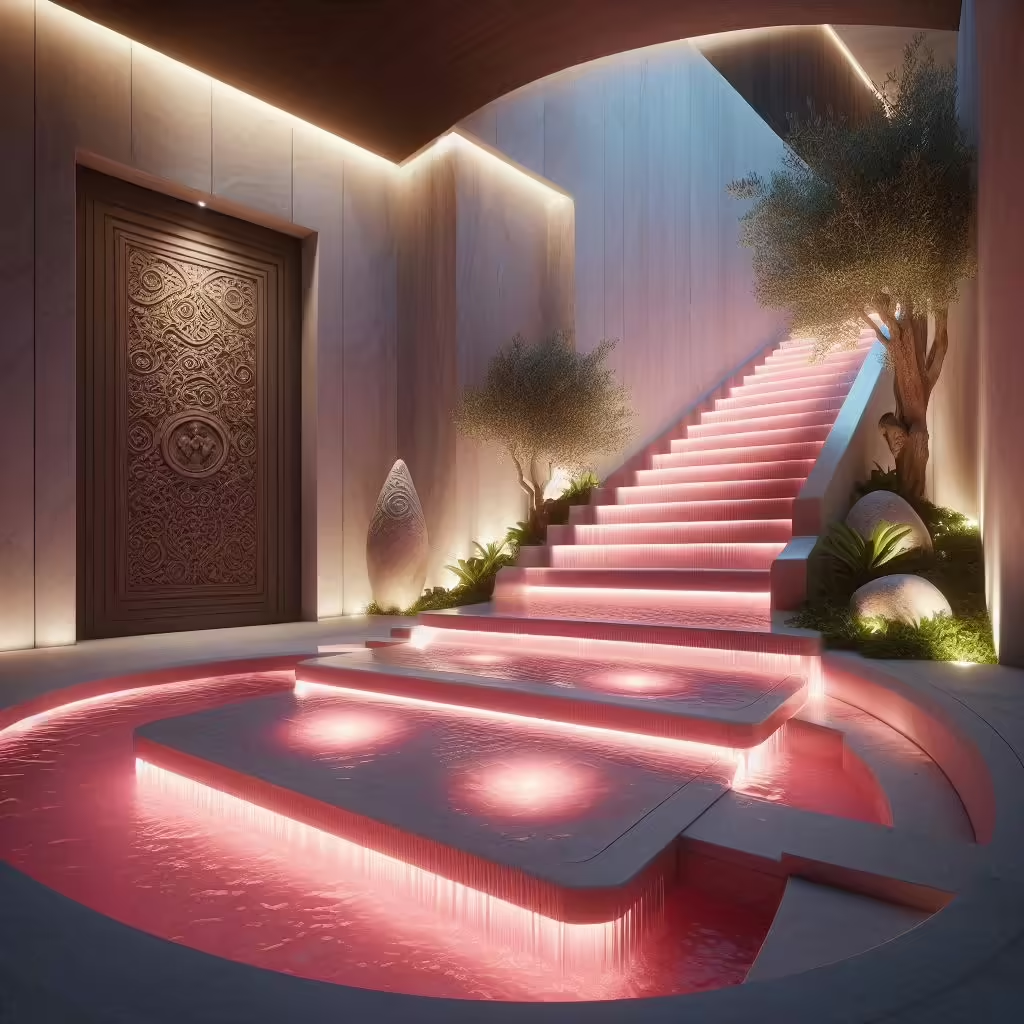
Grand Entryway
A waterfall-inspired staircase makes an excellent centerpiece in a grand entryway. It immediately captures attention and sets the tone for the rest of the home. In large foyers, the fluid design of the staircase can soften the space, creating a welcoming environment.
Open Living Space
If you have an open-concept living area, integrating a waterfall-inspired staircase can serve as a beautiful divider between different functional spaces, such as the living room and dining area. It adds architectural interest without disrupting the flow of the room.
Outdoor Transition
In homes with multiple outdoor levels, such as terraces or balconies, a waterfall-inspired staircase can bridge the different levels seamlessly. Paired with natural landscaping, the staircase will feel like an extension of the outdoor environment.
Maintenance and Safety Considerations
While the aesthetics of a waterfall-inspired staircase are undoubtedly captivating, it’s important to consider the practical aspects as well. Maintenance and safety should always be a priority when designing your staircase.
Regular Cleaning
Glass, wood, and metal staircases require regular cleaning to maintain their shine and prevent wear and tear. Use appropriate cleaning agents for each material to ensure longevity and retain the staircase’s elegance.
Non-Slip Surfaces
Waterfall-inspired staircases, especially those made from materials like glass or stone, may require non-slip treatments to ensure safety. This is especially important in homes with young children or elderly individuals.
Structural Integrity
Ensure that the staircase is built to code and structurally sound. Consult a professional designer and engineer to ensure the design is not only beautiful but also safe and stable.
How to Integrate a Waterfall-Inspired Staircase into Different Home Styles
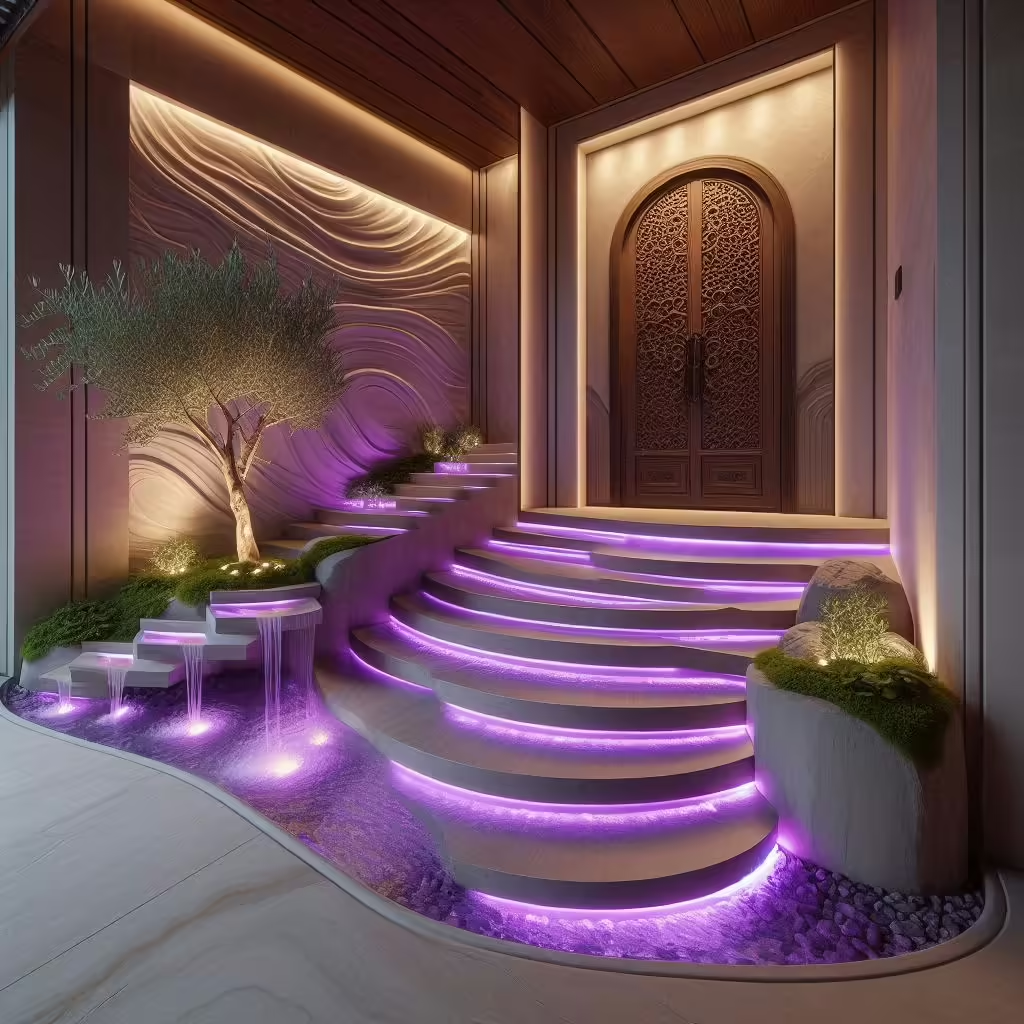
One of the standout features of a waterfall-inspired staircase is its versatility. While the design itself evokes a strong connection to nature, it can be seamlessly integrated into various architectural styles. Here’s how you can adapt this stunning staircase design to fit different home aesthetics.
Modern Homes
In modern homes, the waterfall-inspired staircase pairs perfectly with clean lines, minimalistic furniture, and an open floor plan. To maintain the modern look, materials like glass, metal, and concrete work best. The transparency of glass enhances the airy, open feeling typical of modern spaces, allowing the staircase to stand out while still blending harmoniously with the rest of the home.
Consider incorporating minimalist handrails, or even forgoing traditional railings altogether, replacing them with unobtrusive glass panels to keep the focus on the staircase’s smooth, flowing form.
Traditional Homes
For traditional homes, a waterfall-inspired staircase can take on a more classic feel by using materials like polished wood or stone. The natural curves of the staircase bring a sense of fluidity to the traditional architectural design, offering a refreshing contrast to more rigid lines typically found in such homes.
You can integrate ornate banisters or classic wrought-iron railings to give the staircase a more traditional touch while still maintaining its waterfall-inspired flow. Rich, warm wood tones like oak or cherry can also enhance the natural beauty of the design.
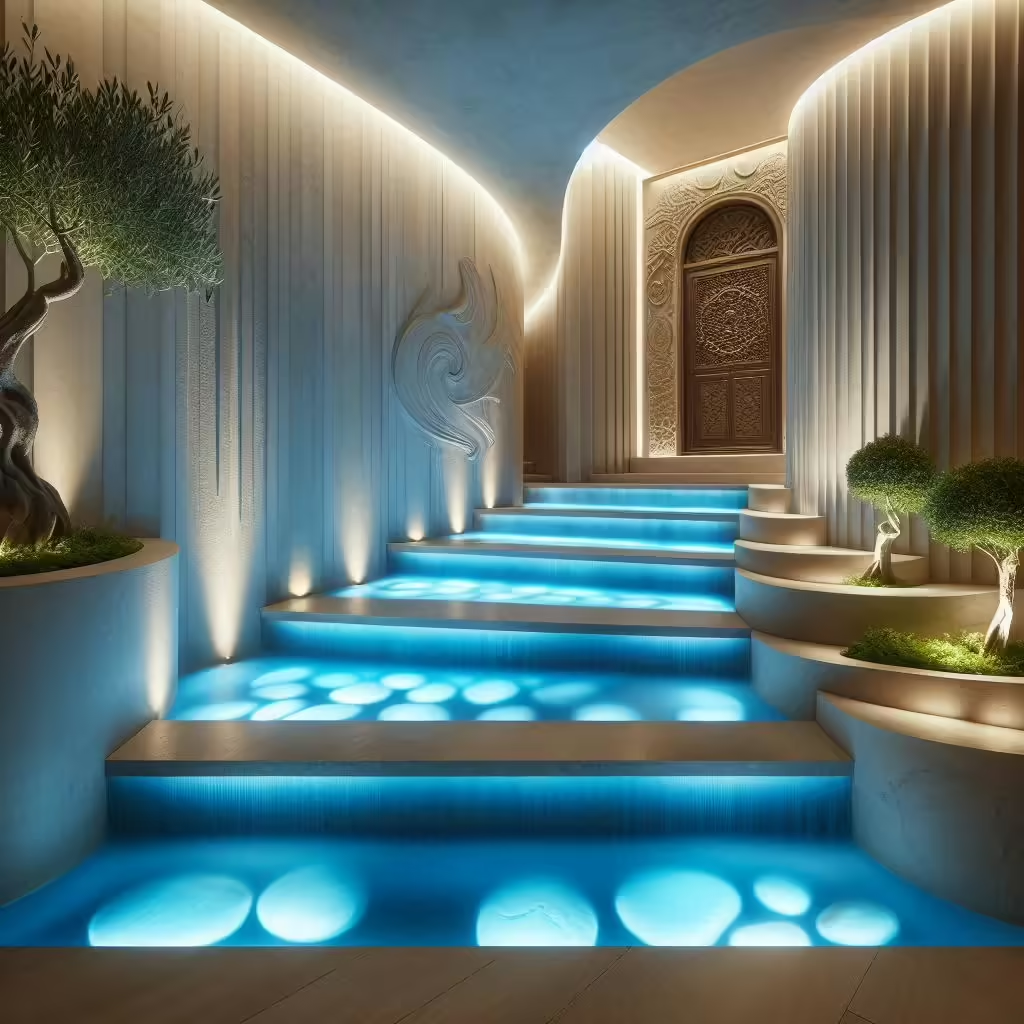
Rustic or Farmhouse Homes
In rustic or farmhouse-style homes, the waterfall-inspired staircase takes on a more organic and earthy feel. Using raw, natural materials like reclaimed wood, stone, or even logs can make the staircase a striking focal point. Imagine a staircase that looks as though it was carved straight from nature, with uneven but smooth wooden steps and rough-hewn stone accents.
Pairing these natural materials with soft lighting will enhance the calming, nature-inspired ambiance that defines the waterfall staircase. This approach not only brings out the rustic charm but also reinforces the connection to the outdoors.
Industrial Style Homes
For industrial-style homes, a waterfall-inspired staircase can add an intriguing balance between the rugged, unfinished elements of industrial design and the soft, flowing lines of nature. Metal is the material of choice in this case, with steel or iron steps creating a sleek, strong base.
You can also introduce concrete or exposed brick for the staircase backdrop, maintaining the industrial vibe while still evoking the sensation of flowing water. The contrast between raw, sturdy materials and the staircase’s smooth, organic shape creates a visually compelling design.
Customizing a Waterfall-Inspired Staircase to Match Your Space
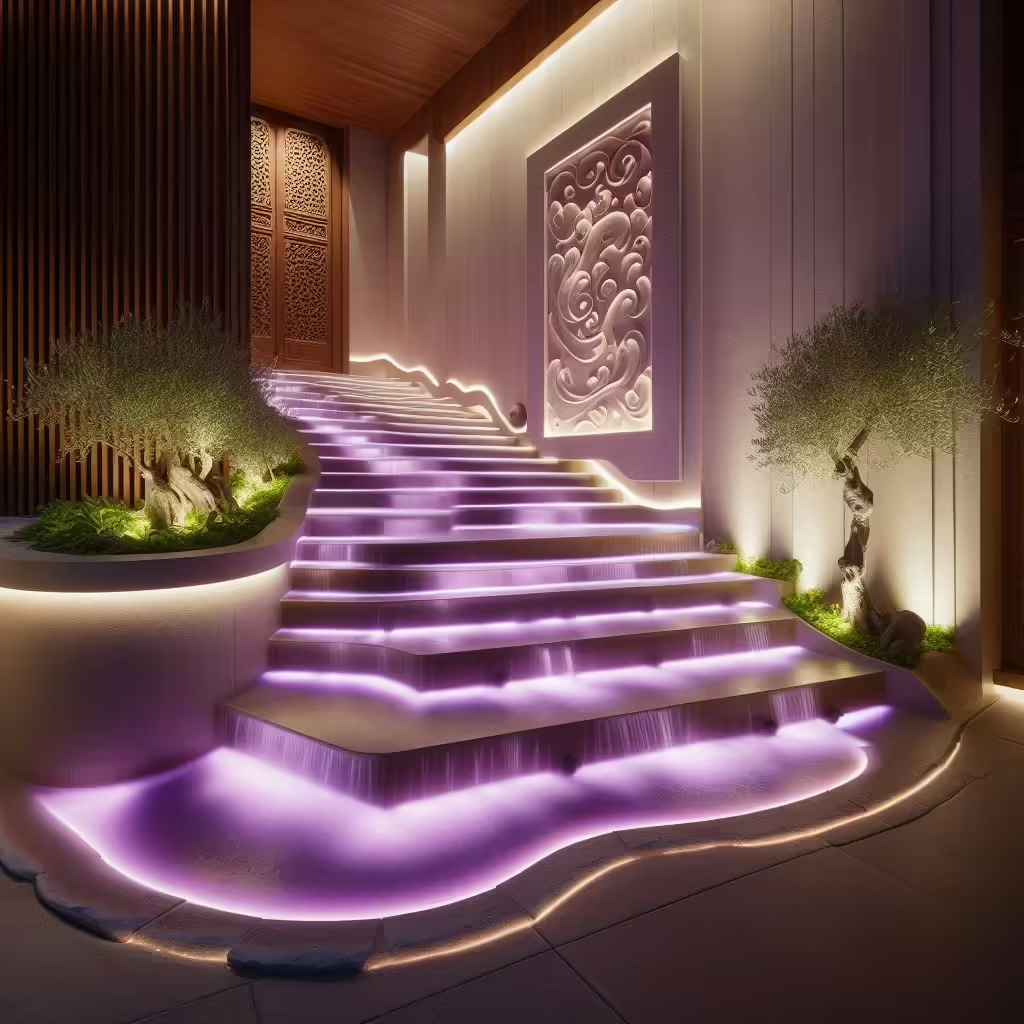
Customizing your waterfall-inspired staircase gives you the freedom to tailor the design to your specific tastes, space limitations, and overall home aesthetic. Here are some popular customization options to consider.
Floating Steps
For an ultra-modern, gravity-defying look, consider floating steps. With the support structure hidden behind walls or cleverly disguised, floating steps appear to hover in mid-air. This not only adds to the ethereal quality of the waterfall-inspired design but also enhances the feeling of spaciousness.
Floating staircases work especially well in minimalist homes where simplicity and clean lines are paramount. The open risers allow light to filter through, further enhancing the natural flow and openness of the staircase.
Water Feature Integration
For the ultimate waterfall effect, consider incorporating an actual water feature alongside or beneath the staircase. This could range from a simple fountain to a more elaborate indoor waterfall installation that mirrors the staircase’s flow.
This approach is ideal for larger homes with expansive stairwells, where you can turn the staircase into an immersive experience. However, it’s crucial to carefully plan water features with proper drainage and maintenance systems to ensure long-term functionality.
Contrasting Treads and Risers
To add visual interest, you can create contrast between the treads (the horizontal part of each step) and risers (the vertical part). For example, you might choose darker wooden treads with lighter stone risers or vice versa. This contrast can emphasize the gentle curves of the staircase while providing a subtle nod to the flowing water theme.
Integrated Storage
If space is at a premium, consider incorporating built-in storage beneath the waterfall-inspired staircase. Shelving, cabinetry, or hidden compartments can be seamlessly integrated into the base of the staircase, providing functionality without compromising the design’s aesthetic.
The Environmental Impact of Waterfall-Inspired Staircases
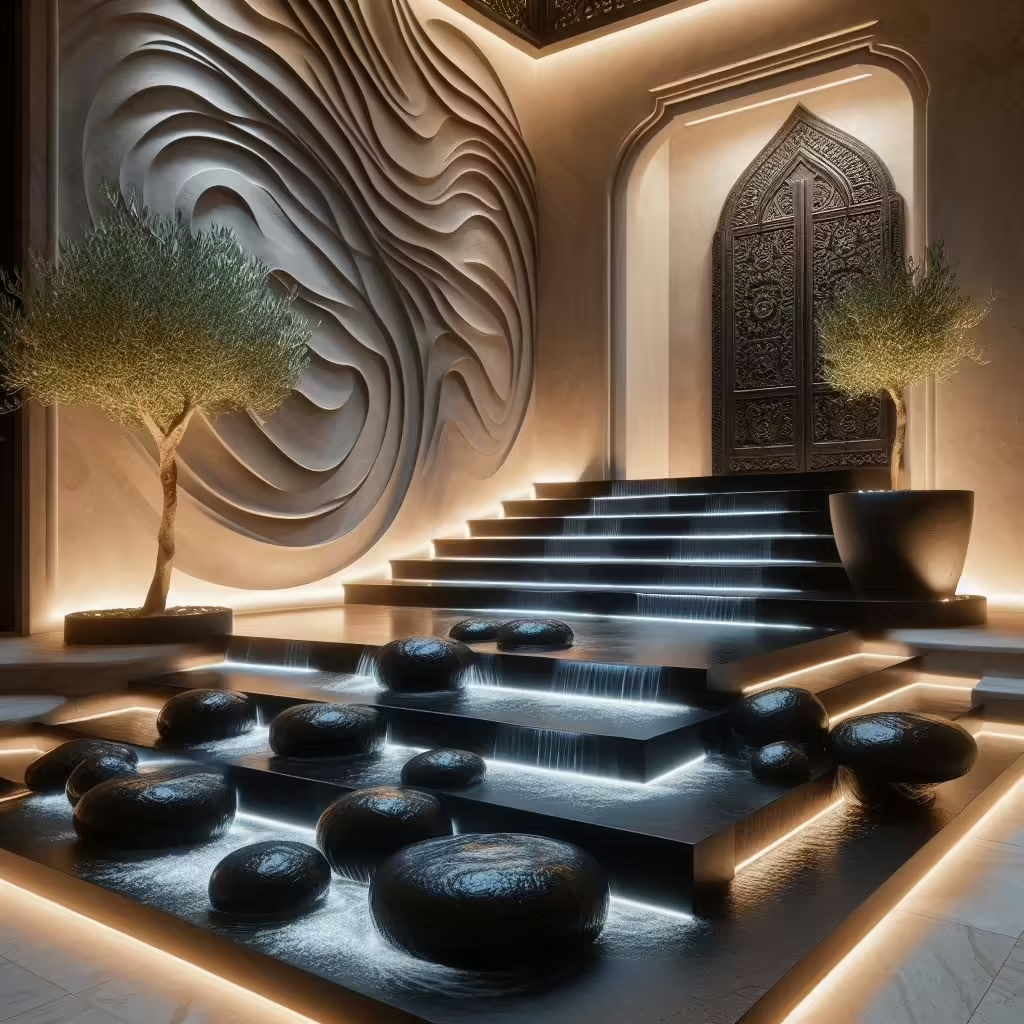
If you’re passionate about sustainability, you can design your waterfall-inspired staircase with environmentally friendly materials and methods. Here’s how you can reduce the environmental impact of your staircase while still creating a stunning visual masterpiece.
Sustainable Materials
Opt for materials that are eco-friendly and sourced responsibly. Reclaimed wood is a fantastic option, adding both character and sustainability to the design. Additionally, recycled glass or metal can be used to construct the staircase without contributing to excessive resource consumption.
Energy-Efficient Lighting
Since lighting plays a critical role in accentuating the waterfall-inspired design, choosing energy-efficient LED lighting is a smart move. Not only do LEDs last longer, but they also consume far less energy compared to traditional bulbs, making your home more eco-friendly.
Low VOC Finishes
Finishes such as paints, stains, and varnishes can contain harmful volatile organic compounds (VOCs) that affect indoor air quality. Opt for low-VOC or VOC-free finishes to ensure that your home remains healthy and environmentally conscious.
Final Thoughts on the Waterfall-Inspired Staircase
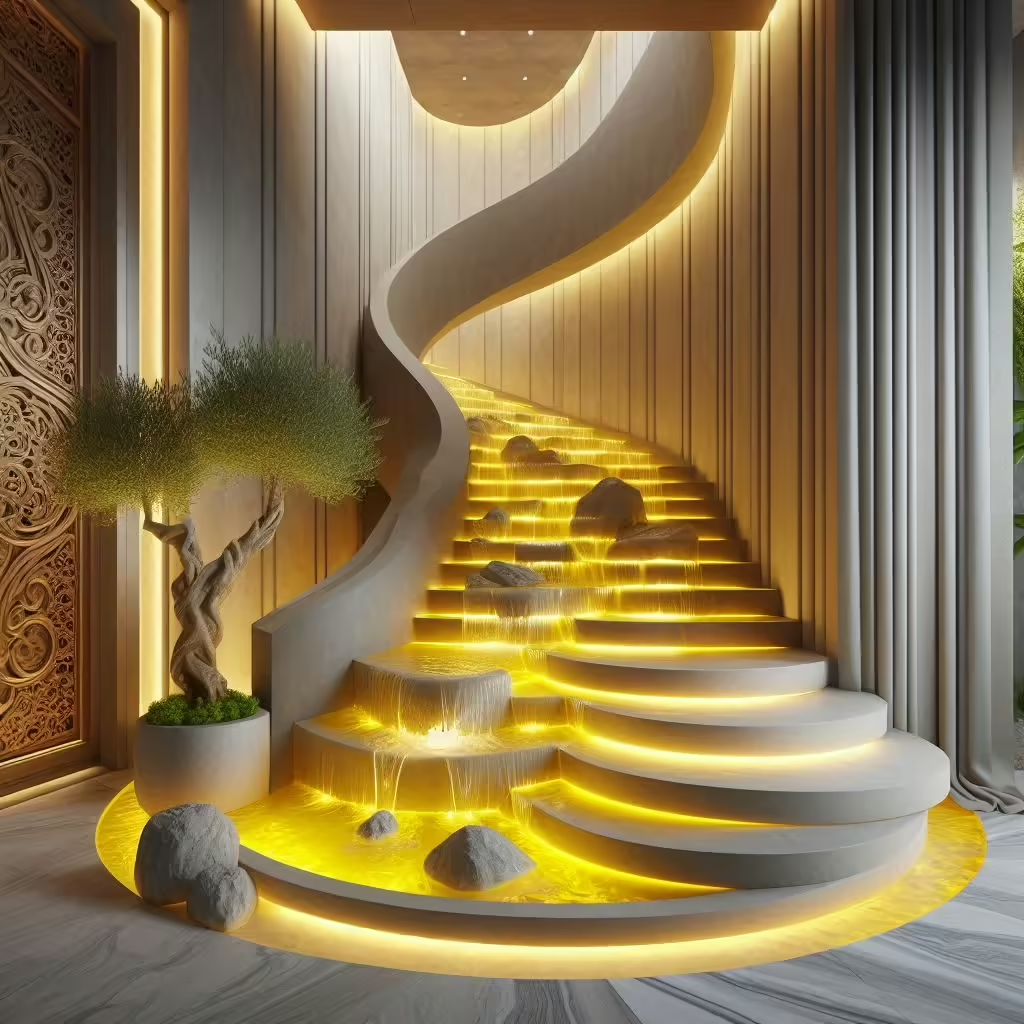
A waterfall-inspired staircase is more than just a functional architectural element—it’s a design statement that embodies the beauty and tranquility of nature. Whether you’re looking to make a bold impression in your home’s entryway or create a peaceful, flowing transition between levels, this design offers the perfect blend of form and function.
By carefully selecting materials, customizing the design to fit your space, and considering eco-friendly options, you can craft a staircase that is as sustainable as it is beautiful. The flowing curves, seamless transitions, and organic shapes will not only enhance your home’s aesthetic but also create a calming environment that offers a retreat from the stresses of daily life.
Incorporating a waterfall-inspired staircase into your home is an investment in both style and substance, giving your space a natural flow that soothes the senses while adding significant architectural value. Whether you lean towards modern minimalism or rustic charm, this staircase design adapts to any style, making it a timeless addition to your home.
